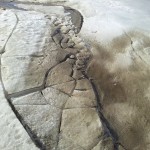 The morning had no particularities unless you count the half-an-inch added to the tiny marigold plants in the front yard.
The morning had no particularities unless you count the half-an-inch added to the tiny marigold plants in the front yard.
Write, get the boys up, get their lunches ready, take them to school. Come back, coffee time on the porch, back to writing.
Routines fragment the day into segments that make it feel familiar and also grow on top of each other as you approach the end of the day, giving you a full measure of where your time went.
If you’re not in a good place, soul uneasy with the action of being, routines are like heavy metal pins nailing you to a ground you do not want to be walking on.
But if you’re in a good place, where you soul resides without frowning, then routines have a magic message written all over them: Life is unshaken. Life where you are is not uprooted by any groundbreaking events. Routines mean you’re safe.
Routines change with time. Growing children, people coming in and out of your life, routines evolve, get dusty, fall to pieces and then they grow into new ones,
But their mere existence is the sign you want, the sun that guides your life with no eclipse shadowing its face. It’s a temporality we’re guilty of misplacing though.
A friend wrote today about his critically ill father. It has come down, and suddenly so, to making the best of the time they still have together. Life is fragile, he wrote. It is, I echoed. It always is.
I let it sink in.
Life as we know it could change at any time. It is not pessimism to think so. Nor is it an invitation to live in fear.
Live. With all that you have. Laugh with your loved ones, share time with them, with friends, with people who mean something to you.
Never wait. Never make concessions on waiting. You’ll always get the short end of the stick. Time, even shorter than it is, because you used it to chew your own misery, your relentless negative thoughts, your fear to connect, to live, to live fully with the awareness that you’re opening a gift with every breath you take. You are.
 Life is fragile… Fluid. There is no going back.
Life is fragile… Fluid. There is no going back.
To live without regrets is not to live mindlessly but to take each morsel of life and taste it. Mindfully present in everything you do and say, in how you share yourself with those you love and love you. Fully. No regrets, never holding back.
I thought of my friend’s dad all day. He will be on my mind for many days. Thoughts, prayers, wishes for being at peace.
Will you, when you’re sitting near that gap that divides our world as we know it from the one we don’t know? If someone will be holding your hand, will they be at peace? Or will there be pockets of unsaid restlessness, life unlived, life gifts you never got to open because you thought you shouldn’t, or you didn’t want to? You saved for later…
Later…Will it come? Would you build a home leaving holes in the walls that are supposed to keep you warm and protected… Would you add those bricks later because now you’re apprehensive, forgetful, mindless, cheeky (yes, we are,) overconfident that later is tomorrow and if not we’ll make it so.
Can you? Can I?
The solid ground I walk on today are routines. Walk back from school, chat, debate, listen, encourage, smile, hug, listen some more because things have to be said again and again, for safety and comfort. Kids’ words pearled up in colliers of worry, and you polish them to a nice safe shine. Every day, the routine of love and providing peace of mind.
Make food, eat, shoo away silliness when it’s teeth brushing time, hugs, say the soft words that you say every night, again and again, pearls of comfort and warmth.
Nighttime drapes, send the photo newsletter, remember where the photo was taken, right near that warning the boys find funny… ‘Uneven terrain, watch your step.’ They snicker, every time… Who would trip on that?
 Some would, I tell them. Some don’t need to be told, some will trip as they read the very words… Warnings we never heed. We know better when we don’t. But then we don’t know much anymore when we’re stopped mid-flight, plunging suddenly and not knowing how deep in.
Some would, I tell them. Some don’t need to be told, some will trip as they read the very words… Warnings we never heed. We know better when we don’t. But then we don’t know much anymore when we’re stopped mid-flight, plunging suddenly and not knowing how deep in.
We will rely on the senses we forgot to use a while ago, we’ll have them revived and sharpened by pain, surprise; we’ll be understanding the meaning of it all. Time. When we had it.
We still do. What now?
Tomorrow, routines again. It’ll mean nothing has changed. I am safe. Aware. Mindful.
You?











